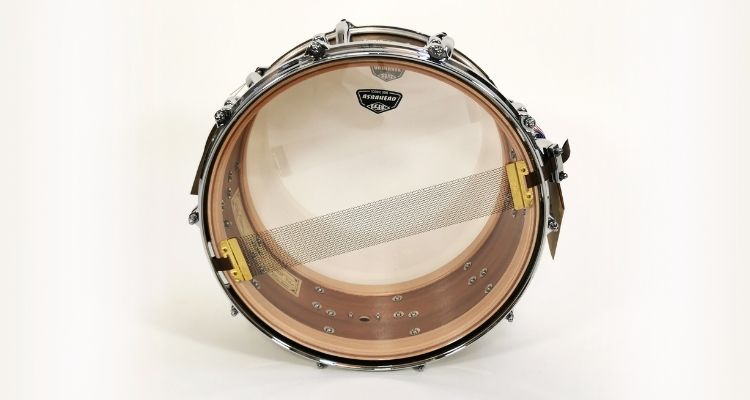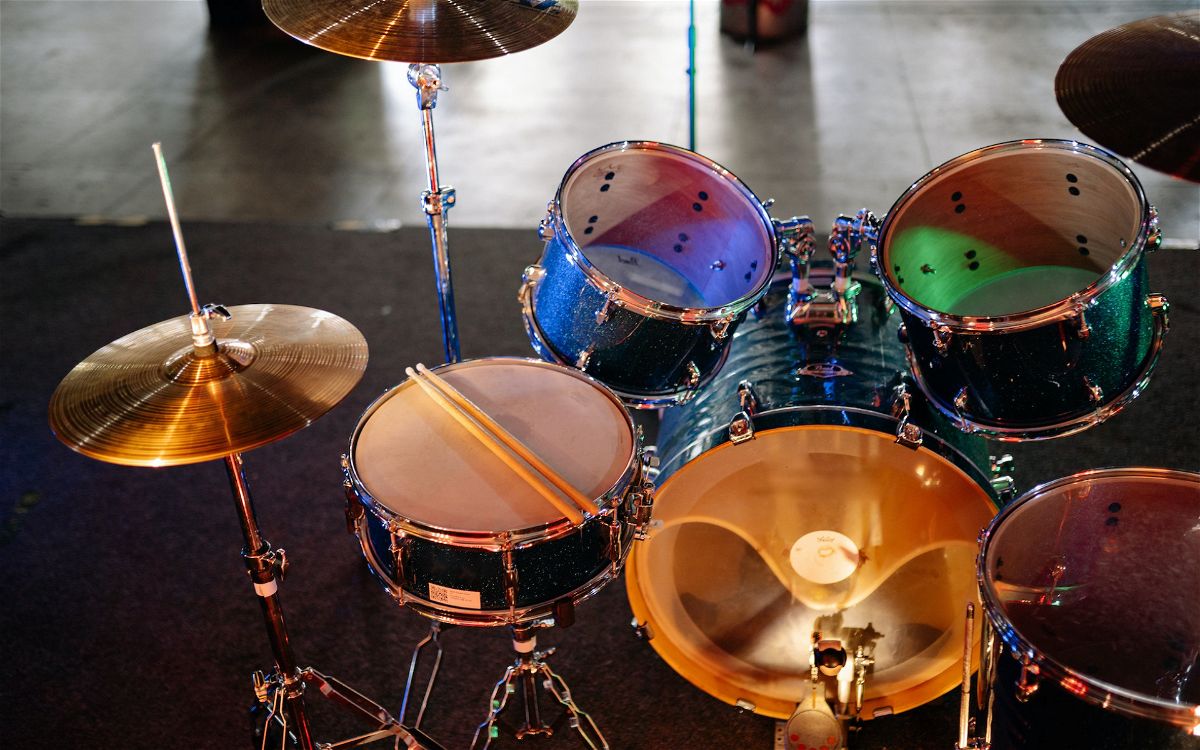All drums require a set of drumheads to produce sounds. You’ll always get a stock set when purchasing a kit, but your drums will sound far better if you upgrade to a set of higher-quality ones from brands like Remo, Evans, and Aquarian.
If you’re ready to get new drumheads, you may be wondering which ones are the best options. The two main categories are coated and clear heads, and each type offers something slightly different.
Here’s a guide to understanding those differences and figuring out which drumhead type you should get.
Contents
Coated Drum Heads

Coated drumheads feature a white textured coating across the entire surface of the drumhead, and they bring out warm and round tones from your drums.
They also have a bit more articulation than what you get from clear heads. This means that your strokes are a bit sharper and more distinct.
They tend to offer less resonance, so you’ll find that drums with coated heads don’t need to be muffled as much as drums with clear heads.
Most snare drums have coated heads on them, as the snare wires react better with a coated batter head.
You also need to use coated drumheads if you want to play with brushes. The thicker texture of a coated head is what gives you the sandpaper feeling, while brushes don’t work well at all on clear heads.
Clear Drum Heads

Clear drumheads are completely transparent and they offer a snappier and brighter attack compared to coated heads.
Visibly speaking, they allow you to see the insides of your drum shells when you have them on your kit.
The main difference between these and coated heads is that they offer slightly more attack. The brighter sounds bring more resonance out of the shells, causing them to ring for a bit longer.
Some drummers may use a clear drumhead on their snare drum, but it’s not recommended. You get a brighter sound, but you lose a bit of stick articulation. That makes ghost notes harder to hear.
One of the drawcards of using clear heads is that you get several different color options. The standard color is transparent, but you can find black, red, blue, and purple heads being sold by various brands.
The different colors don’t affect how the heads sound. They just look great on certain kits, and they’re good for achieving a certain aesthetic for videos or live gigs.
Clear vs Coated Drum Heads
Both types of drumheads work perfectly for most situations. You’ll just get subtle tonal differences from your drums.
Here’s a quick table comparing all the main differences between clear and coated drum heads.
| Feature | Coated Drumheads | Clear Drumheads |
|---|---|---|
| Tone | Warm, dark, and mellow. | Bright, open, and sharp. |
| Sustain | Fewer overtones and a focused sound. | More overtones and a ringier sound. |
| Styles | Ideal for all styles, particularly for brush playing due to the textured surface. | Ideal for all styles but commonly favored for rock and pop. |
| Advantages | Warmer tone, focused response, reduced overtones. | Bright and punchy tone, longer sustain. |
Best Drumhead Options for Different Situations

Rock Drumming
Both coated and clear drumheads are good choices for rock drumming. You just need to decide what qualities you prefer.
Classic rock could work better with coated heads, as you’ll get the warm tom tones that were so popular in the 60s, 70s, and 80s.
Modern rock drumming may work better with clear heads on your toms. You’ll get more attack and resonance, making the drums sound louder and more powerful.
I’d recommend that you still use a coated drumhead for your snare drum, though. There are very few situations where I think using a clear head on a snare is a good idea.
Jazz Drumming
A jazz drum kit setup benefits from coated heads far more than clear ones. The warmer tones cater better to jazz instrumentation.
With that said, you should also make sure that you’re using single-ply coated heads. While they’re warmer than clear heads, the thinner nature of single-ply heads will also ensure that you get plenty of tone out of the drum shells.
When you tighten single-ply heads tightly on a small jazz kit, you get some beautifully resonant tones.
The fact that jazz drumming often requires a drummer to use brushes is another reason why coated heads are so important.
The one place where you could happily use a clear drumhead would be for the bass drum. Just make sure not to muffle the shell too much, and you’ll get that beloved resonant jazz bass drum sound.
Resonant Heads

A resonant head is the drumhead that gets placed on the bottom side of a drum shell. All drum kits come with clear reso heads as the stock ones, and most drummers tend to keep those stock heads on the kit.
You get more of an impact from changing the batter heads than you do from the resonant ones. This stops many drummers from ever changing resonant heads.
However, replacing the stock resonant heads may be the final step to achieving the best drum sounds you can possibly get.
If you choose to put coated heads on the bottom sides of your shells, your drums will sound slightly warmer.
Just make sure to put single-ply heads on the resonant side of every drum, as double-ply heads will kill the tones.
Studio Recording
Studio engineers tend to prefer coated heads over clear ones most of the time. Since coated heads are warmer with fewer overtones, they’re a bit easier to control in a drum mix. You don’t need to do as much tweaking, and less muffling leads to purer tones.
However, clear heads will be used when that’s the sound that a studio engineer is going for. The brighter and more aggressive nature makes them a better choice for high-energy styles.
Again, this is mostly for the toms and kick drum. Snare drums will always use coated drumheads in studio environments.
Live Gigging
Clear drumheads have a bigger impact in live gigging situations. Since they offer brighter and more aggressive sounds, they tend to be a bit louder, and that’s great for environments where you need a bit of energy on stage.
However, the difference isn’t big enough to say that clear heads are definitely better. You’ll still get a great drum sound with coated heads.
You should also consider thickness here. When you’re playing with a lot of energy, you’ll hit the drums harder, and thicker drumheads will last much longer.
Video Recording

The final aspect to mention is video creation. This is a bit of a loose topic, as you can happily use both clear and coated heads for drum videos.
However, you need to keep lighting in mind. The best way to get great drum videos is to have good lighting over your drum kit.
One of the issues that come with lighting is that the lights tend to reflect off of clear drumheads, and that can be very distracting in a shot.
You can position the lights in various ways to stop that from happening, but you could also use coated drumheads to get a much better filming setup experience.
Other Things to Consider
Single vs Double Ply Drumheads
Whether you get coated or clear drumheads, another big thing that affects how they sound is thickness.
Single-ply heads are the thinnest type and they tend to bring more tone out of your drums. Along with that tone comes all the features offered by clear or coated heads.
Double-ply drumheads offer a more controlled sound. You get less resonance, and you also don’t have to muffle your drums as much to get rid of unwanted overtones. They’re thicker in design, but I’d also say that the sounds you get are thicker.
Many drummers prefer using single-ply heads if they own high-end drum sets. That’s what gives them the best possible sounds. However, single-ply heads aren’t nearly as durable as double-ply ones, so they need to be replaced more often.
Specialty Drumheads
Some drumheads are designed with unique features that break the mold of coated or clear heads. Every drumhead brand offers something like this, and you’ll get varying tonal qualities that depend on how the plies and coatings are placed on those heads.
You may find drumheads that blend the two designs, or you may find ones that give you unique materials for specified sounds.
These types of drumheads aren’t as popular as typical coated and clear ones, but they’re definitely interesting options to consider.
Final Thoughts
Both clear and coated drumheads are excellent options. You just need to choose the appropriate type for the sounds that you’re looking for. You then have to decide if you want single or double-ply heads.
Coated drumheads tend to be more popular for most situations, but clear drumheads can make a big impact when you’re looking for a powerful drum kit sound. It’s also highly appealing that you can get clear drumheads in various colors.









